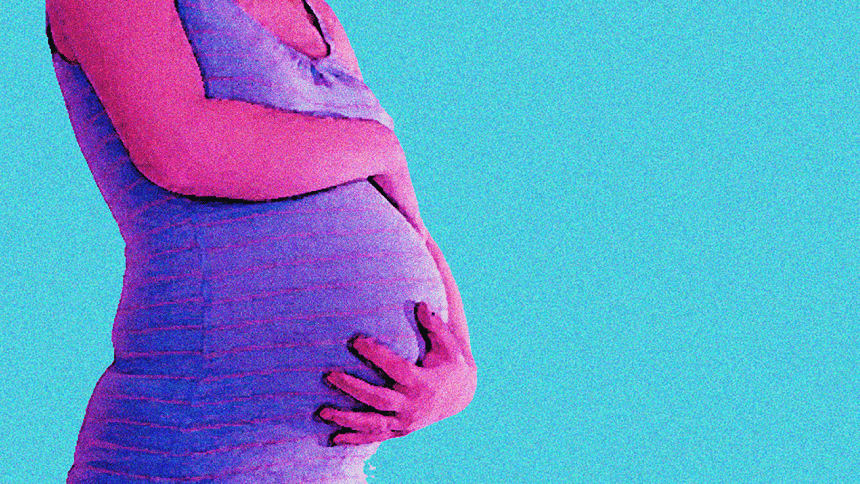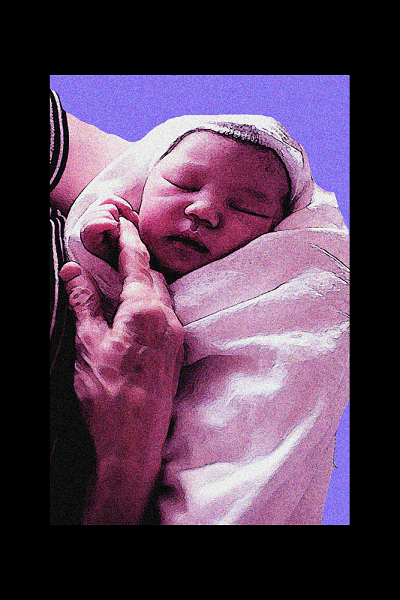The curious case of the C-section

It was Shazneen Begum's second pregnancy. Like the birth of her first child, she was hoping for a normal delivery this time as well. In the 38th week, her water broke and she was taken to a well-known private hospital of the city.
Over there, the doctor at the emergency room—much to her surprise—told her that she would have to undergo a caesarean section, since the baby's stool (meconium) had gotten mixed with the amniotic fluid in which the baby floats inside the mother's womb.
A caesarean section or a c-section is the delivery of a baby through a surgical incision in the mother's abdomen and uterus. Typically, it's a cut of around six inches made in the mother's lower abdomen after which the uterus is opened and the baby is delivered.
The incision is later stitched closed. Ideally, it's a process that should be used only when there's an emergency and when the life of either the baby or the mother is in danger. However, in Bangladesh, experts say that more than 80 percent of the deliveries in private hospitals are caesarean.
Upon hearing the doctor's opinion, Shazneen asked if she could wait for labour to start, since she really wanted a normal delivery. However, the doctor replied: "You could, but the responsibility of any negative outcome will not be mine."
It was a statement, Shazneen recalls, which compelled her to undergo the surgery. "Looking back, I feel that the manner in which the doctor communicated with me was not supportive and it was also a bit threatening. I was just told that it was going to be complicated. I was never explained the risks associated with stool (meconium) mixed in the amniotic fluid properly," she says.
After getting discharged from the hospital, Shazneen, who works as a public health specialist, learned that the standard procedure for cases like hers is to wait for labour to begin. Instead of taking the patient under the knife, the medical staff is expected to wait and monitor the baby's heart rate.
Eventually, Shazneen gave birth to a healthy baby who weighed 3.8 kgs and she recovered quickly as well. However, the ethical practice of the doctor in this particular case remains a question.
The rate of c-section births has witnessed an alarming increase in the last decade in Bangladesh. In fact, in urban areas, surgical deliveries in private hospitals—especially in the capital—have become so common that normal births are almost unheard of these days.
According to the Demographic and Health Survey of 2014, 80 percent of the births that take place in private hospitals and around 40 percent of births in government-based hospitals are surgical. On the whole, 23 percent of all births in Bangladesh, in between 2011 to 2014, were delivered by c-section.
This statistic, which is expected to cross the 30 percent mark in September according to experts, when an updated survey is set to be released, has already surpassed the World Health Organisation's (WHO) recommendation.
According to WHO, the ideal range of c-section births in a country should be around 10 to 15 percent. In 2004, the number of c-section births in Bangladesh was just 4 percent. In a span of ten years, Bangladesh has witnessed a five-fold increase in the number of c-section deliveries.
Risks and needs of caesarean births
So why is this a worrying indicator? That's because births through c-section tend to be riskier and have more disadvantages when compared to normal deliveries.
Women who undergo caesarean surgeries are more likely to have an infection, excessive bleeding, blood clots, more postpartum pain, a longer hospital stay, and a significantly longer recovery. Injuries to the bladder or bowel, although very rare, can also take place.
Studies have also found that babies born by elective c-section before 39 weeks are more likely to have breathing problems than babies who are delivered vaginally or by emergency c-section. In addition to this, if a mother plans to have more children, each c-section increases the risk of complications.
But this definitely doesn't mean that all c-sections must be prevented. C-section is actually a life-saving surgery, which at times, is the only safe option for mothers and babies.
The question remains as to whether the boom in the number of surgical deliveries in Bangladesh is justifiable. Dr Ishtiaq Mannan, director of the Save the Children's health, nutrition and HIV/Aids wing, certainly doesn't think so. According to him, most of the caesarean deliveries in Bangladesh are unnecessary.
"Firstly, we have to understand that cesarean operations are increasing globally. The more access that a population has to hospitals, the number of caesarean operations is likely to increase. We should know that around 38 percent of births in Bangladesh now take place in medical facilities, which is an increase from the past.
"However, the rate at which c-sections has increased in Bangladesh is questionable. C-section should only be applied on deliveries that cannot be accomplished normally. It's a life-saving surgery after all. Going by that logic, the increase in the number of c-sections should ideally lead to a much lesser maternal mortality ratio (MMR). But that is not the case," explains Mannan.
The maternal mortality rate or the MMR is the annual number of female deaths per 100,000 live births from any pregnancy-related cause. As of 2015, Bangladesh's MMR stands at 176.
What Mannan is highlighting is that if a majority of the c-section surgeries in Bangladesh were actually used in emergency cases then the MMR would have been a lot lesser. Unfortunately, a large number of mothers, who actually require c-section surgeries, don't have access to it.

A dirty business
Mannan states three reasons behind the increase in c-sections in Bangladesh—lack of quality control in hospitals, a financial incentive and poor ethical standards.
"When it comes to private hospitals, you have to understand that there's a business involved here. A doctor will earn around Tk 15,000 for a caesarean birth as compared to Tk 2,000 for a normal birth. Although doctors are ethically trained, there are times when they become a part, or are forced to become a part, of the overall business structure of the hospital.
"In one of my research I found that there is a market of around Tk 1200 crore for caesarean births in Bangladesh, of which half is unnecessary. So, under such circumstances it won't be wrong to say that there's a business interest here," explains Mannan.
"Because there is no strong quality control system there is a possibility that hospitals may look forward to making more profits," he adds.
The increase in stress among patients
While Mannan speaks more about the business behind the caesarean births, various experienced gynecologists attribute the increase in c-section deliveries to the change in lifestyle among women in the country.
"There are a lot of factors involved here, right from a patient's dietary patterns to the stress that they take at work and at home. I get a number of cases these days where patients decide beforehand that they want a c-section delivery because they want to join work back in time. They also don't want to deal with the pain of reaching term," says Dr. Syeda Husna Akhter, former senior consultant, Department of Obstetrics and Gynecology, Dhaka Medical College Hospital.
"And then there are cases where patients, who have plenty of access to information regarding pregnancy, get more worried than they should. Just the other day I conducted a cesarean operation on a woman who weighed 110 kgs. She was tense right from the start. She was telling me that her baby wasn't moving and a number of issues that she was having. She kept complaining.
"When a patient tells you that your baby is not moving, as a doctor you really can't take a risk," she adds.
The increase in tension among pregnant women, according to Dr. Syeda, adversely affects their body during pregnancy.
"When you are tense because of your in-laws or problems at homes, a hormone that is supposed to be released in your body, which dilates the cervix, is not released.
So there are patients who complete 37 or 40 weeks, but still don't get any pain. Even if they reach term, their cervix does not dilate. Even if patients want normal births, there are times when the baby does not come out," explains Dr. Syeda.
She admits that there are problems with c-sections and it is likely to vary with regards to the experience of the doctors.
"An operation can always have a side effect. Why would you cut an area that does not need to be cut? It might be a serious problem in villages because not all doctors there are very experienced. I was surprised to know that both the children of my maid were caesareans. It's something that's spreading and with less experienced doctors, the operation might be more risky," she opines.
The introduction of midwives
Professor Laila Arhumand Banu, the president of the Obstetrical and Gynecological Society of Bangladesh, believes that trained midwives can help reduce the rate of c-section deliveries. A midwife is someone who is trained to assist a woman during birth.
" One of the reasons why c-section has increased is because our junior medical officers often can't afford to give much time to patients. We used to sit and wait for mothers to deliver their child normally for hours. But these medical officers tend to be busier today.
"And that's why we have provided a proposal to attach a patient with a midwife. This is actually what happens outside. A midwife is responsible for the patient when she is pregnant and even after the baby is born. A doctor is only seen during the operation," explains Dr. Banu.
"We are still in the process of training midwives and it will take a few years before they can enter labour rooms. Until then, we are planning to give short-term training to traditional helpers and make them assist patients," she adds.
Some say that healthcare is a product which is provider-induced. This basically means that we are almost always dependent upon the doctor's words. However, with no trustworthy quality control system in place in hospitals, there is a chance for the system to go haywire on a regular basis. And this is the reason why you get to witness absurd statistics. For instance, that 80 percent of births in private hospitals is caesarean is a lot, even by South Asian standards. That number in India, in comparison, is 50 percent. The health minister recently spoke up against unnecessary c-section deliveries in the parliament. Government officials have also made ambitious statements, which said that the rate of c-section deliveries would come down drastically in the near future. However, judging by the current scenario, it's clear that there's still a long way to go before the right balance can be struck.

 For all latest news, follow The Daily Star's Google News channel.
For all latest news, follow The Daily Star's Google News channel. 



Comments